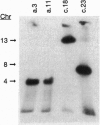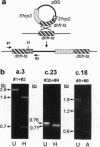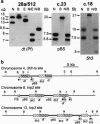Abstract
Plasmodium falciparum malaria parasites were transformed with plasmids containing P. falciparum or Toxoplasma gondii dihydrofolate reductase-thymidylate synthase (dhfr-ts) coding sequences that confer resistance to pyrimethamine. Under pyrimethamine pressure, transformed parasites were obtained that maintained the transfected plasmids as unrearranged episomes for several weeks. These parasite populations were replaced after 2 to 3 months by parasites that had incorporated the transfected DNA into nuclear chromosomes. Depending upon the particular construct used for transformation, homologous integration was detected in the P. falciparum dhfr-ts locus (chromosome 4) or in hrp3 and hrp2 sequences that were used in the plasmid constructs as gene control regions (chromosomes 13 and 8, respectively). Transformation by homologous integration sets the stage for targeted gene alterations and knock-outs that will advance understanding of P. falciparum.
Full text
PDF
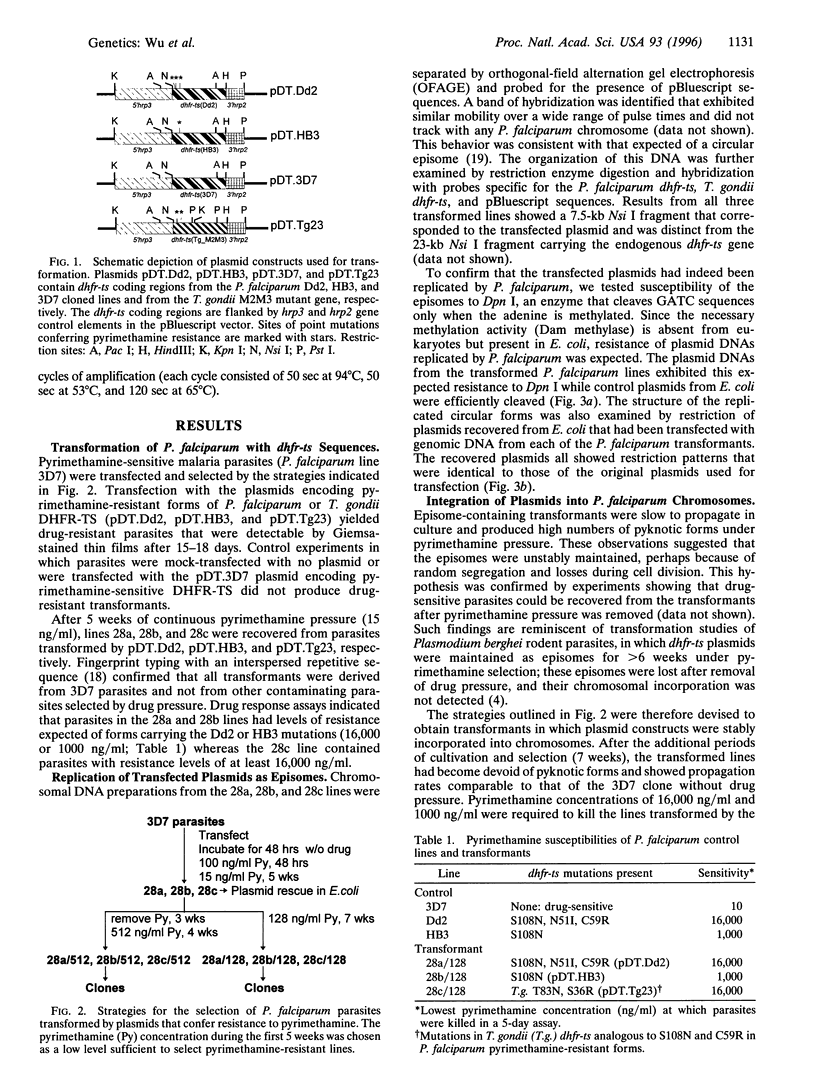
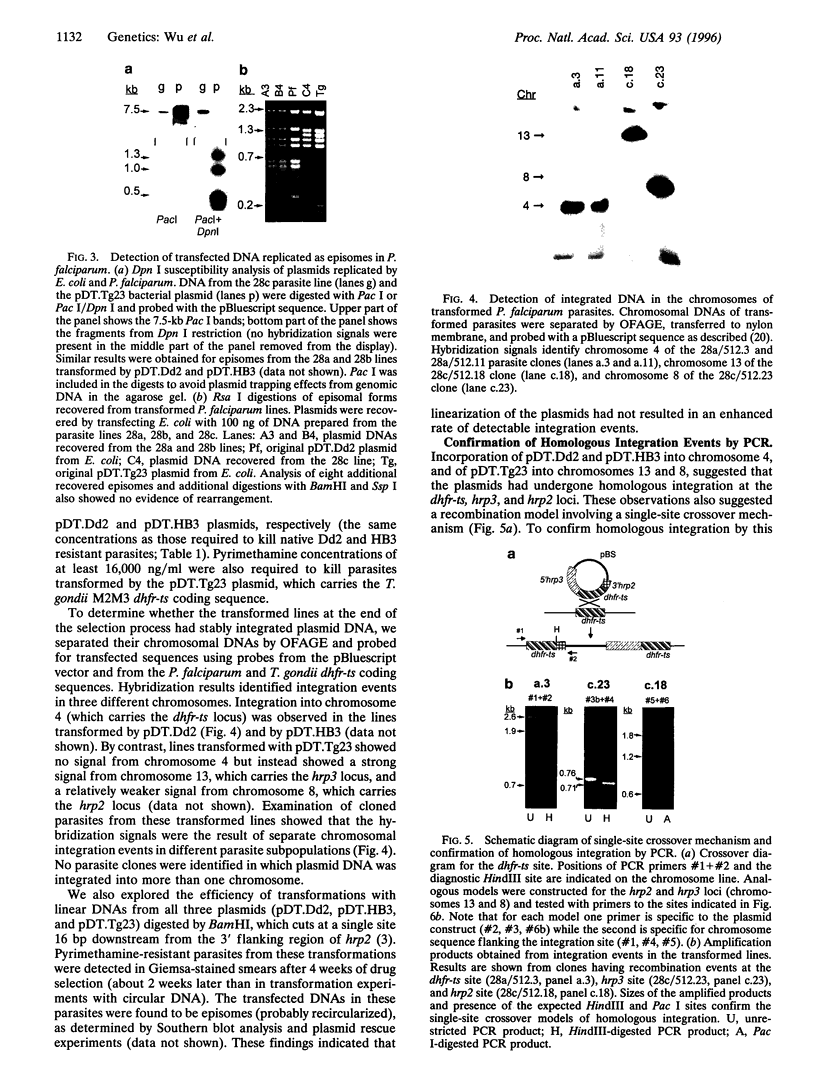
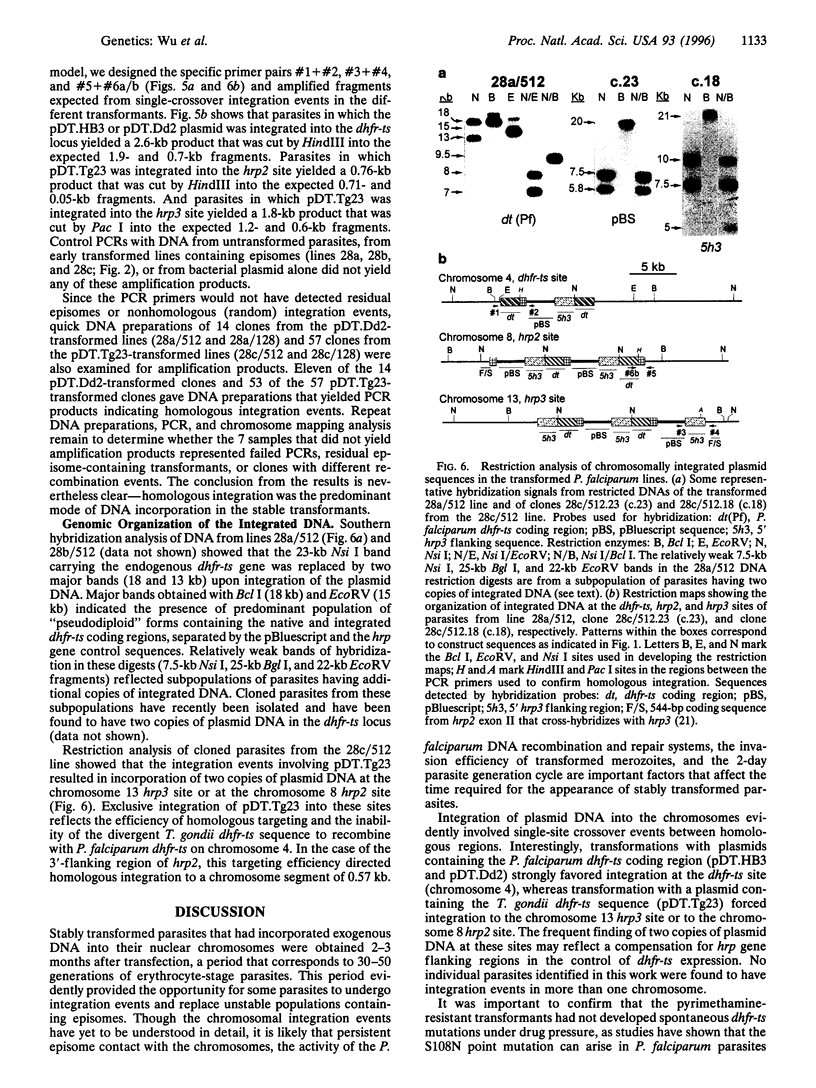
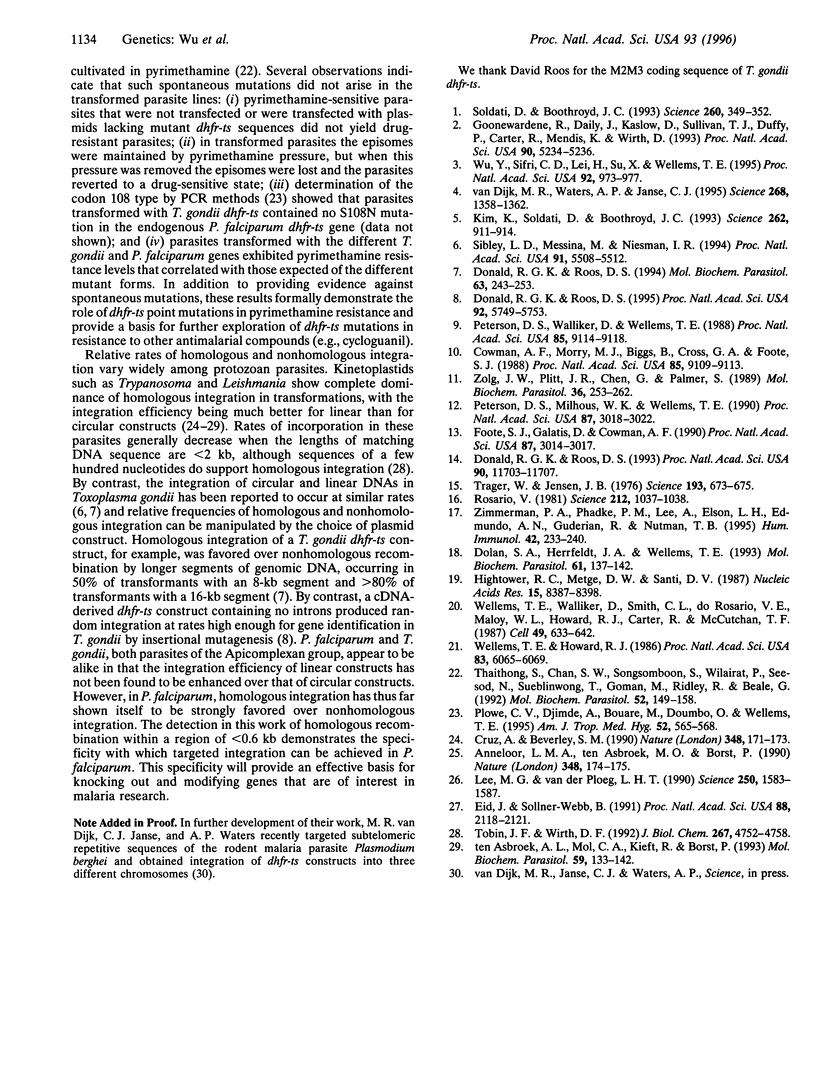
Images in this article
Selected References
These references are in PubMed. This may not be the complete list of references from this article.
- Cowman A. F., Morry M. J., Biggs B. A., Cross G. A., Foote S. J. Amino acid changes linked to pyrimethamine resistance in the dihydrofolate reductase-thymidylate synthase gene of Plasmodium falciparum. Proc Natl Acad Sci U S A. 1988 Dec;85(23):9109–9113. doi: 10.1073/pnas.85.23.9109. [DOI] [PMC free article] [PubMed] [Google Scholar]
- Cruz A., Beverley S. M. Gene replacement in parasitic protozoa. Nature. 1990 Nov 8;348(6297):171–173. doi: 10.1038/348171a0. [DOI] [PubMed] [Google Scholar]
- Dolan S. A., Herrfeldt J. A., Wellems T. E. Restriction polymorphisms and fingerprint patterns from an interspersed repetitive element of Plasmodium falciparum DNA. Mol Biochem Parasitol. 1993 Sep;61(1):137–142. doi: 10.1016/0166-6851(93)90166-u. [DOI] [PubMed] [Google Scholar]
- Donald R. G., Roos D. S. Homologous recombination and gene replacement at the dihydrofolate reductase-thymidylate synthase locus in Toxoplasma gondii. Mol Biochem Parasitol. 1994 Feb;63(2):243–253. doi: 10.1016/0166-6851(94)90060-4. [DOI] [PubMed] [Google Scholar]
- Donald R. G., Roos D. S. Insertional mutagenesis and marker rescue in a protozoan parasite: cloning of the uracil phosphoribosyltransferase locus from Toxoplasma gondii. Proc Natl Acad Sci U S A. 1995 Jun 6;92(12):5749–5753. doi: 10.1073/pnas.92.12.5749. [DOI] [PMC free article] [PubMed] [Google Scholar]
- Donald R. G., Roos D. S. Stable molecular transformation of Toxoplasma gondii: a selectable dihydrofolate reductase-thymidylate synthase marker based on drug-resistance mutations in malaria. Proc Natl Acad Sci U S A. 1993 Dec 15;90(24):11703–11707. doi: 10.1073/pnas.90.24.11703. [DOI] [PMC free article] [PubMed] [Google Scholar]
- Eid J., Sollner-Webb B. Stable integrative transformation of Trypanosoma brucei that occurs exclusively by homologous recombination. Proc Natl Acad Sci U S A. 1991 Mar 15;88(6):2118–2121. doi: 10.1073/pnas.88.6.2118. [DOI] [PMC free article] [PubMed] [Google Scholar]
- Foote S. J., Galatis D., Cowman A. F. Amino acids in the dihydrofolate reductase-thymidylate synthase gene of Plasmodium falciparum involved in cycloguanil resistance differ from those involved in pyrimethamine resistance. Proc Natl Acad Sci U S A. 1990 Apr;87(8):3014–3017. doi: 10.1073/pnas.87.8.3014. [DOI] [PMC free article] [PubMed] [Google Scholar]
- Goonewardene R., Daily J., Kaslow D., Sullivan T. J., Duffy P., Carter R., Mendis K., Wirth D. Transfection of the malaria parasite and expression of firefly luciferase. Proc Natl Acad Sci U S A. 1993 Jun 1;90(11):5234–5236. doi: 10.1073/pnas.90.11.5234. [DOI] [PMC free article] [PubMed] [Google Scholar]
- Hightower R. C., Metge D. W., Santi D. V. Plasmid migration using orthogonal-field-alternation gel electrophoresis. Nucleic Acids Res. 1987 Oct 26;15(20):8387–8398. doi: 10.1093/nar/15.20.8387. [DOI] [PMC free article] [PubMed] [Google Scholar]
- Kim K., Soldati D., Boothroyd J. C. Gene replacement in Toxoplasma gondii with chloramphenicol acetyltransferase as selectable marker. Science. 1993 Nov 5;262(5135):911–914. doi: 10.1126/science.8235614. [DOI] [PubMed] [Google Scholar]
- Lee M. G., Van der Ploeg L. H. Homologous recombination and stable transfection in the parasitic protozoan Trypanosoma brucei. Science. 1990 Dec 14;250(4987):1583–1587. doi: 10.1126/science.2177225. [DOI] [PubMed] [Google Scholar]
- Peterson D. S., Milhous W. K., Wellems T. E. Molecular basis of differential resistance to cycloguanil and pyrimethamine in Plasmodium falciparum malaria. Proc Natl Acad Sci U S A. 1990 Apr;87(8):3018–3022. doi: 10.1073/pnas.87.8.3018. [DOI] [PMC free article] [PubMed] [Google Scholar]
- Peterson D. S., Walliker D., Wellems T. E. Evidence that a point mutation in dihydrofolate reductase-thymidylate synthase confers resistance to pyrimethamine in falciparum malaria. Proc Natl Acad Sci U S A. 1988 Dec;85(23):9114–9118. doi: 10.1073/pnas.85.23.9114. [DOI] [PMC free article] [PubMed] [Google Scholar]
- Plowe C. V., Djimde A., Bouare M., Doumbo O., Wellems T. E. Pyrimethamine and proguanil resistance-conferring mutations in Plasmodium falciparum dihydrofolate reductase: polymerase chain reaction methods for surveillance in Africa. Am J Trop Med Hyg. 1995 Jun;52(6):565–568. doi: 10.4269/ajtmh.1995.52.565. [DOI] [PubMed] [Google Scholar]
- Rosario V. Cloning of naturally occurring mixed infections of malaria parasites. Science. 1981 May 29;212(4498):1037–1038. doi: 10.1126/science.7015505. [DOI] [PubMed] [Google Scholar]
- Sibley L. D., Messina M., Niesman I. R. Stable DNA transformation in the obligate intracellular parasite Toxoplasma gondii by complementation of tryptophan auxotrophy. Proc Natl Acad Sci U S A. 1994 Jun 7;91(12):5508–5512. doi: 10.1073/pnas.91.12.5508. [DOI] [PMC free article] [PubMed] [Google Scholar]
- Soldati D., Boothroyd J. C. Transient transfection and expression in the obligate intracellular parasite Toxoplasma gondii. Science. 1993 Apr 16;260(5106):349–352. doi: 10.1126/science.8469986. [DOI] [PubMed] [Google Scholar]
- Thaithong S., Chan S. W., Songsomboon S., Wilairat P., Seesod N., Sueblinwong T., Goman M., Ridley R., Beale G. Pyrimethamine resistant mutations in Plasmodium falciparum. Mol Biochem Parasitol. 1992 Jun;52(2):149–157. doi: 10.1016/0166-6851(92)90047-n. [DOI] [PubMed] [Google Scholar]
- Tobin J. F., Wirth D. F. A sequence insertion targeting vector for Leishmania enriettii. J Biol Chem. 1992 Mar 5;267(7):4752–4758. [PubMed] [Google Scholar]
- Trager W., Jensen J. B. Human malaria parasites in continuous culture. Science. 1976 Aug 20;193(4254):673–675. doi: 10.1126/science.781840. [DOI] [PubMed] [Google Scholar]
- Wellems T. E., Howard R. J. Homologous genes encode two distinct histidine-rich proteins in a cloned isolate of Plasmodium falciparum. Proc Natl Acad Sci U S A. 1986 Aug;83(16):6065–6069. doi: 10.1073/pnas.83.16.6065. [DOI] [PMC free article] [PubMed] [Google Scholar]
- Wellems T. E., Walliker D., Smith C. L., do Rosario V. E., Maloy W. L., Howard R. J., Carter R., McCutchan T. F. A histidine-rich protein gene marks a linkage group favored strongly in a genetic cross of Plasmodium falciparum. Cell. 1987 Jun 5;49(5):633–642. doi: 10.1016/0092-8674(87)90539-3. [DOI] [PubMed] [Google Scholar]
- Wu Y., Sifri C. D., Lei H. H., Su X. Z., Wellems T. E. Transfection of Plasmodium falciparum within human red blood cells. Proc Natl Acad Sci U S A. 1995 Feb 14;92(4):973–977. doi: 10.1073/pnas.92.4.973. [DOI] [PMC free article] [PubMed] [Google Scholar]
- Zimmerman P. A., Phadke P. M., Lee A., Elson L. H., Aruajo E., Guderian R., Nutman T. B. Migration of a novel DQA1* allele (DQA1*0502) from African origin to North and South America. Hum Immunol. 1995 Mar;42(3):233–240. doi: 10.1016/0198-8859(94)00107-2. [DOI] [PubMed] [Google Scholar]
- Zolg J. W., Plitt J. R., Chen G. X., Palmer S. Point mutations in the dihydrofolate reductase-thymidylate synthase gene as the molecular basis for pyrimethamine resistance in Plasmodium falciparum. Mol Biochem Parasitol. 1989 Oct;36(3):253–262. doi: 10.1016/0166-6851(89)90173-4. [DOI] [PubMed] [Google Scholar]
- ten Asbroek A. L., Mol C. A., Kieft R., Borst P. Stable transformation of Trypanosoma brucei. Mol Biochem Parasitol. 1993 May;59(1):133–142. doi: 10.1016/0166-6851(93)90014-o. [DOI] [PubMed] [Google Scholar]
- ten Asbroek A. L., Ouellette M., Borst P. Targeted insertion of the neomycin phosphotransferase gene into the tubulin gene cluster of Trypanosoma brucei. Nature. 1990 Nov 8;348(6297):174–175. doi: 10.1038/348174a0. [DOI] [PubMed] [Google Scholar]
- van Dijk M. R., Waters A. P., Janse C. J. Stable transfection of malaria parasite blood stages. Science. 1995 Jun 2;268(5215):1358–1362. doi: 10.1126/science.7761856. [DOI] [PubMed] [Google Scholar]




